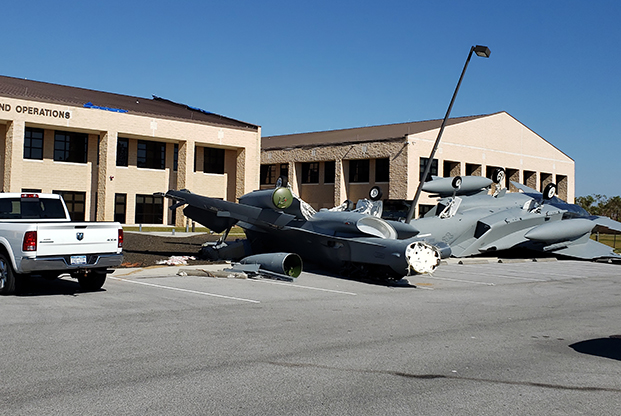
Two static display aircraft, an F-16 and an F-15, were tossed from their displays and damaged when Hurricane Michael struck Tyndall AFB, Fla., on Oct. 10. Staff photo by Brian Everstine.
TYNDALL AFB, Fla. — The airmen tasked with assessing the catastrophic damage caused by Hurricane Michael and with beginning to rebuild the base said at first the job seemed too big.
“The base was wrecked, honestly,” said CMSgt. Michael Huckaby, the chief of airfields for the 823rd RED HORSE Squadron at nearby Hurlburt Field, Fla. “The first impressions when we got on base was that this base will never operate again. It was a disaster area.”
The 823rd RED HORSE was one of the first to respond. The 60-mile drive to Tyndall, through the chaos of Panama City and the surrounding area on Oct. 11, took about five hours. The base was covered with sheet metal, insulation, furniture, and shattered trees, but the squadron immediately got to work clearing routes and assessing the damage.
The day after the storm, there were about 90 people on the base—the essential personnel tasked with riding out the storm. RED HORSE worked alongside special tactics airmen, base defenders, and contingency response airmen to get the flight line operational and the base back to limited operations. By Wednesday when Air Force Magazine got a chance to visit, there were more than 1,300 airmen on the base and flight operations were regularly taking place.
Shortly after the storm, airmen with the 635th Materiel Maintenance Group at Holloman AFB, N.M.—the Air Force’s only Basic Expeditionary Airfield Resources (BEAR) unit—piled into C-17s carrying tents and other temporary infrastructure to Tyndall to provide needed housing for the airmen responding to the storm.
Within three days, the BEAR team built 60 tents. About a week and a half later, they were up to 84 tents, which housed most of the 1,300 airmen working to put the base back together, along with three “clam shells,” or large aircraft maintenance hangars, on the flight line where the Air Force evaluated the damage to the F-22s that couldn’t relocate before the storm. The BEAR team is now replacing generators with larger, more efficient power units for longer-term use, which means more showers and more hot meals for airmen.
“Without providing the living condition for the warfighters, the mission wouldn’t be going on,” said CMSgt. Pete Seagrift, the 635th MMS squadron superintendent. “If we didn’t have a place to house people, and shower them, and feed them, and everything else, you ain’t getting morale. You ain’t getting the work that you need. Without tent city, without BEAR base, your mission and morale are going to suffer.”
The response is the largest single rapid deployment for the BEAR unit, said 2nd Lt. Jacob Berggren, the 635th’s materiel management flight commander.
The job of rebuilding an airfield is specifically what RED HORSE does. East of the flightline, in what was a dense forest, sits the Silver Flag detachment, where USAF civil engineers conduct pre-deployment training and practice rebuilding contingency air bases.
“This is a base recovery and a civil engineering unit. In a contingency environment, that is our primary mission,” Huckaby said. “This is one of the only opportunities that people get in their careers to do what we train to do, and that is to recover a base. It doesn’t get any more real than this.”
But in mid-October as initial reports of damage came in, Headquarters Air Force officials initially said the Silver Flag training exercises would likely have to be moved. The training area took a heavy blow, but as airmen began to assess the facilities, they determined it is not only possible, but likely, they could get the mission back.
As of Wednesday, four of 57 buildings had to be demolished, and those are already being replaced with large tents. The facilities kitchen was destroyed, and a bear even got into the building and ransacked the airmen’s MREs.
The airmen rebuilding Silver Flag are working 14 hour days, and up until this week were bathing with sponges or water spickets. “It is very personal. You can feel the heart behind it,” said Capt. Chaz Enbody, a project engineer with the 823rd who is overseeing the Silver Flag response.
“We want it,” she said about keeping the Silver Flag mission at Tyndall. “And I think we’re going to get it.”
The 823rd devised a plan and a timeline for recovering the mission, one that is realistic for both the detachment and for the Air Force, Huckaby said.
“If we didn’t believe we could do it, these airmen wouldn’t be … busting their ass,” he said.
On Friday afternoon, the Air Force announced the Silver Flag mission would definitely stay at Tyndall, though the base remains under a mandatory evacuation order, meaning the airmen who are assigned there are not yet able to return. Many, though, are helping over the phone, directing some of the response through their expertise and familiarity of the base.
“This is why we do what we do. It has an impact on every person here at Tyndall,” Huckaby said. “To go to the Middle East and help the war effort is important, and I support it 100 percent, but to help your people here that have just lost everything, it means a lot more. … To help a fellow citizen is important.”
